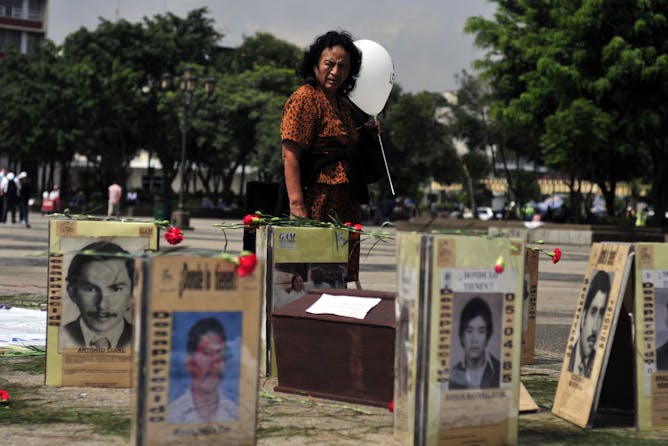|
Forced disappearances were notoriously a favoured tool of Latin American dictatorships in the 1970s and 1980s, but today, they seem to be on the rise around the world. Rodwan Abouharb has been researching why this particular human rights violation making a comeback, and has found evidence that countries keen to clear up their record of extrajudicial killings are simply turning to disappearances instead.
The recent acquittal of a farmer who shot and killed a young unarmed Indigenous man on a farm in Saskatchewan has ignited outrage in Canada. Vicki Chartrand of Bishop’s University explores how Canada’s justice system “works against Indigenous people at every level, from police checks and arrests to bail denial and detention.
|

A Guatemalan woman searches for the portrait of her disappeared niece on the International Day of the Disappeared.
EPA/Luis Soto
Rodwan Abouharb, UCL
In an age of increased scrutiny, violent and repressive states are turning to subtler methods of removing dissidents and opponents.
|
Politics + Society
|
-
Vicki Chartrand, Bishop's University
Colten Boushie's death and the subsequent acquittal of his killer has fuelled loud calls for reforms to Canada's criminal justice system and its treatment of the Indigenous. Why has it taken so long?
-
Myriam Benraad, Leiden University
Was the early conception of IS a branching-out of the old Baath party? Or was it, as some argue, completely separate with no connection at all? Reality is probably a bit of a mix of both.
-
Keith Parry, Western Sydney University; Emma Kavanagh, Bournemouth University; Ryan Storr, Western Sydney University
A country with a questionable stance on LGBTI+ rights is again hosting the Winter Olympics.
-
Yohannes Gedamu, Georgia Gwinnett College
Now that Ethiopia's prime minister has made public his intention to resign, can the country's ruling coalition hold?
|
|
Environment + Energy
|
-
Manoj Dora, Brunel University London
Climate change could hurt Indian farmers' income by up to 20-25% in the medium term.
-
Ellis Adjei Adams, Georgia State University
New ways of managing water have emerged in some of Africa's urban and peri-urban areas.
|
|